Thoughts on this Thursday
Irons and Smoothers and Mangles...on my!!
No-one can say exactly when people started trying to press cloth smooth, but we know that the Chinese were using hot metal for ironing before anyone else. Pans filled with hot coals were pressed over stretched cloth as illustrated in the drawing to the right. A thousand years ago this method was already well-established.
Meanwhile people in Northern Europe were using stones, glass and wood for smoothing. These continued in use for "ironing" in some places into the mid-19th century, long after Western blacksmiths started to forge smoothing irons in the late Middle Ages.
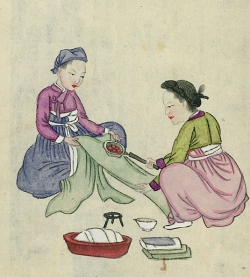
Linen smoothers: stones, glass, presses
Flattish hand-size stones could be rubbed over woven cloth to smooth it, polish it, or to press in pleated folds. Simple round linen smoothers made of dark glass have been found in many Viking women's graves, and are believed to have been used with smoothing boards. Archaeologists know there were plenty of these across medieval Europe, but they aren't completely sure how they were used. Water may have been used to dampen linen, but it is unlikely the smoothers were heated.
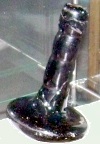 More recent glass smoothers often had handles, like these from Wales, or the English one in the picture (left). They were also called slickers, slickstones, sleekstones, or slickenstones. Decorative 18th and 19th century glass smoothers in "inverted mushroom" shape may turn up at antiques auctions. Occasionally they are made of marble or hard wood.
More recent glass smoothers often had handles, like these from Wales, or the English one in the picture (left). They were also called slickers, slickstones, sleekstones, or slickenstones. Decorative 18th and 19th century glass smoothers in "inverted mushroom" shape may turn up at antiques auctions. Occasionally they are made of marble or hard wood.Mangle boards, box mangles
 Even in modest homes with no presses, large items needed to be tackled with something bigger than a slickstone. They could be smoothed with a mangle board and rolling pincombination; many wonderfully carved antique Scandinavian or Dutch mangle boards have been preserved by collectors. The board, often carved by a young man for his bride-to-be, was pressed back and forth across cloth wound on the roller.
Even in modest homes with no presses, large items needed to be tackled with something bigger than a slickstone. They could be smoothed with a mangle board and rolling pincombination; many wonderfully carved antique Scandinavian or Dutch mangle boards have been preserved by collectors. The board, often carved by a young man for his bride-to-be, was pressed back and forth across cloth wound on the roller.Flat irons, sad irons
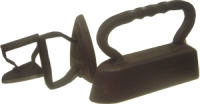 Blacksmiths started forging simple flat irons in the late Middle Ages. Plain metal irons were heated by a fire or on a stove. Some were made of stone, like these soapstone irons from Italy. Earthenware and terracotta were also used, from the Middle East to France and the Netherlands.
Blacksmiths started forging simple flat irons in the late Middle Ages. Plain metal irons were heated by a fire or on a stove. Some were made of stone, like these soapstone irons from Italy. Earthenware and terracotta were also used, from the Middle East to France and the Netherlands.
Flat irons were also called sad irons or smoothing irons. Metal handles had to be gripped in a pad or thick rag. Some irons had cool wooden handles and in 1870 a detachable handle was patented in the US. This stayed cool while the metal bases were heated and the idea was widely imitated. (See these irons from Central Europe.) Cool handles stayed even cooler in "asbestos sad irons". The sad in sad iron (or sadiron) is an old word for solid, and in some contexts this name suggests something bigger and heavier than a flat iron. Goose or tailor's goose was another iron name, and this came from the goose-neck curve in some handles. In Scotland people spoke of gusing (goosing) irons.
You'd need at least two irons on the go together for an effective system: one in use, and one re-heating. Large households with servants had a special ironing-stove for this purpose. Some were fitted with slots for several irons, and a water-jug on top.
More information at
http://www.oldandinteresting.com/antique-irons-smoothers-mangles.aspx
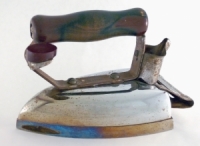
Early electric irons
Electrical self-heating flat-irons, electric sad-irons
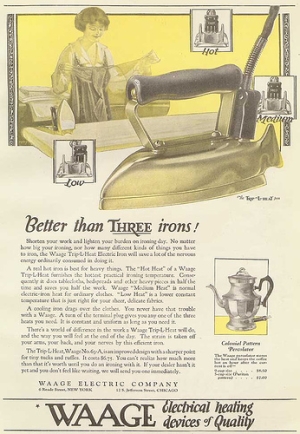 The search for a foolproof "self-heating flat iron" was under way by the mid-19th century. In 1852 a patent was issued in the US for a new, improved charcoal-burning iron which would make "practicable the permanent heating of smoothing irons". By 1860 there were gas irons available in several countries, with rubber tubing to connect them to gas light fittings or to canisters, and then there were numerous designs for irons with internal burners and little piggyback tanks of liquid fuel.
The search for a foolproof "self-heating flat iron" was under way by the mid-19th century. In 1852 a patent was issued in the US for a new, improved charcoal-burning iron which would make "practicable the permanent heating of smoothing irons". By 1860 there were gas irons available in several countries, with rubber tubing to connect them to gas light fittings or to canisters, and then there were numerous designs for irons with internal burners and little piggyback tanks of liquid fuel.
The Hotpoint iron, designed by Earl H. Richardson of Ontario, California, was launched in 1905, and was the first electric iron to have any commercial success. By the 1920s enough people had homes wired for electricity for electric clothes irons to spread fast across the US. They were also selling well in some parts of Europe.
MANGLE. A domestic machine of great utility, employed in smoothening linen, as a substitute for the heated irons extensively used for the same purpose. In the common mangle, as most of our readers well know, the linen or other articles to be mangled, are wrapped round wooden rollers, which are upon a solid level bed or floor, and upon the rollers is placed a large oblong box which is filled with stones, or other heavy substances, in order that they may press with great force upon the rollers, while the box is moved backwards and forwards upon them, by means of a handle attached to an upper roller or windlass, to which straps from each end of the moving box are attached. By this machine, the operation of mangling is very well done, but the labour is excessive on account of the necessity of frequently arresting and changing the motion of the heavy box.The Engineer's and Mechanic's Encyclopaedia, London 1838
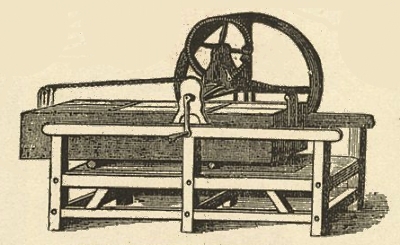
My grandmother, the one who also made soap, had a mangle. Not like the one above but useful in managing her rooming house. She ironed sheets and pillowcases and anything else that would go through. I was not allowed near it and I can't say that I wanted to be near it.
I'm so glad that we live now when there are so many kinds of irons to choose from. I love learning about the old days but I'm glad I live now.
*************************************
Wishing you much success in planning for your day of Thanksgiving next week. We will celebrate with part of our family and eat well, I'm sure.
~~~~~~~~~~~~~~~~~~~~~~~~
Classes this week include Open Sew on Sunday from 11-4
No Doll quilt class this month.
Today we are sewing Maggie B projects.
After Thanksgiving Saturday November 28 is our Celebrate Spargo Day!
10-4. You are welcome to come and sew on anything.
*****************
Enjoy your day.
Thanks, Betty
thequiltingb1947@gmail.com
Etsy Store
https://www.etsy.com/people/thequiltingb1947



Comments
Post a Comment